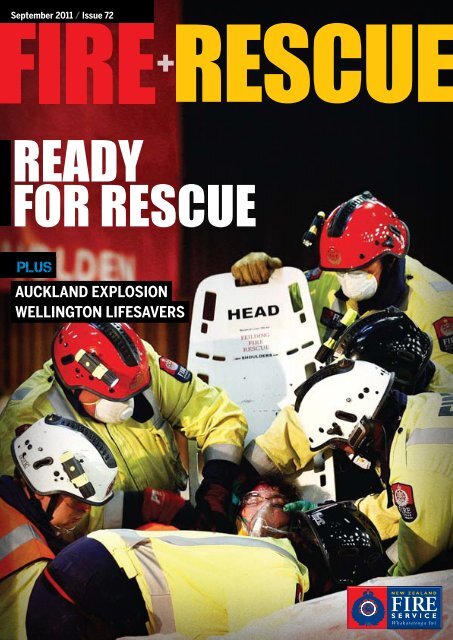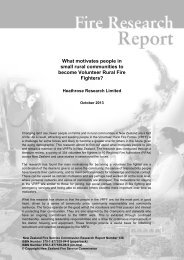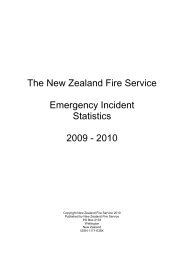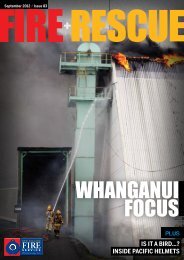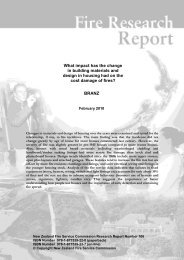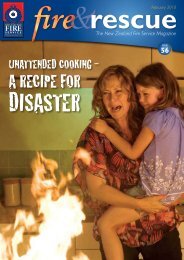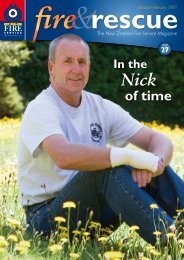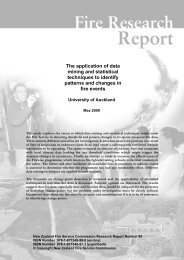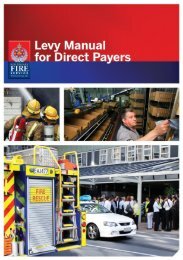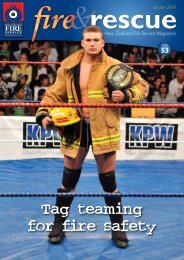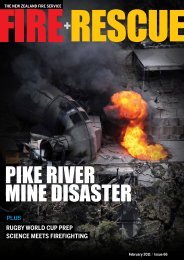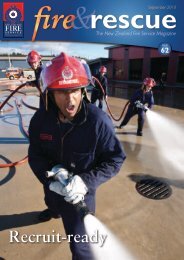Fire + Rescue Issue 72 - New Zealand Fire Service
Fire + Rescue Issue 72 - New Zealand Fire Service
Fire + Rescue Issue 72 - New Zealand Fire Service
Create successful ePaper yourself
Turn your PDF publications into a flip-book with our unique Google optimized e-Paper software.
September 2011 / <strong>Issue</strong> <strong>72</strong><br />
Ready<br />
foR <strong>Rescue</strong><br />
Plus<br />
AucklAnd ExploSIon<br />
WEllIngton lIfESAvErS
thE nEW zEAlAnd fIrE SErvIcE<br />
<strong>Fire</strong>+<strong>Rescue</strong> is the flagship<br />
publication of the <strong>New</strong> <strong>Zealand</strong><br />
<strong>Fire</strong> <strong>Service</strong>.<br />
It is produced by Media,<br />
Promotions and Communications,<br />
National Headquarters,<br />
Level 9, 80 The Terrace, Wellington.<br />
contrIbutIonS to fIrE+rEScuE<br />
We welcome ideas for articles, news<br />
and events that would be of interest to<br />
other <strong>Fire</strong> <strong>Service</strong> staff and volunteers.<br />
Draft articles and photos (pictures<br />
need to be at least 1MB) can be<br />
emailed to fire.rescue@fire.org.nz or<br />
contact the editor Karlum Lattimore<br />
on 04 496 3702.<br />
Post written material and photos,<br />
or photo CDs to:<br />
<strong>Fire</strong>+<strong>Rescue</strong> magazine,<br />
PO Box 2133, Wellington.<br />
(These will be returned on request.)<br />
WWW.fIrE.org.nz<br />
All material in <strong>Fire</strong>+<strong>Rescue</strong> magazine<br />
is copyrighted and may not be<br />
reproduced without the permission<br />
of the editor.<br />
ISSN: 1176-6670 (Print)<br />
ISSN: 1177-8679 (Online)<br />
front covEr<br />
The Feilding team competes<br />
at the recent RCR challenges.<br />
Photo: Dominion Post.<br />
2 / <strong>Fire</strong>+<strong>Rescue</strong> / September 2011<br />
Team Talk<br />
It’s all about teamwork. When a<br />
few of the All Blacks dropped in to<br />
talk to Christchurch emergency service<br />
personnel the discussion was about the<br />
team response to the earthquake.<br />
kIWI flIES hIgh In AuStrAlIA<br />
A former <strong>New</strong> <strong>Zealand</strong> firefighter<br />
has recently become the second<br />
Kiwi to be awarded the Australian<br />
<strong>Fire</strong> <strong>Service</strong>s Medal.<br />
Bruce Jones, Western Australia’s Regional<br />
Director <strong>Fire</strong> and Emergency <strong>Service</strong>s<br />
Authority (FESA), was recognised in the<br />
Queen’s Birthday Honours List for his<br />
work to improve fire and rescue services,<br />
including the introduction of major<br />
incident management training.<br />
Bruce served in the NZFS for 27 years<br />
from the early 1970s until his appointment<br />
to FESA in 1997.<br />
He worked largely in Auckland, rising<br />
through the ranks to become Divisional<br />
Officer Training in Auckland City and then<br />
National Training Manager in Wellington<br />
in the mid-1990s.<br />
Bruce Jones was and still is well known for<br />
his pioneering work in rescue extrication.<br />
He led much of the development of this<br />
The players met with Police and <strong>Fire</strong><br />
personnel and their families in late July.<br />
The kids made the most of a chance<br />
to meet their sporting heroes while the All<br />
Blacks showed their appreciation for the<br />
work of their parents during the earthquake.<br />
Two rugby shirts signed by the All Blacks team were presented to the Christchurch Police and <strong>Fire</strong> <strong>Service</strong>.<br />
From left: Ma’a Nonu, Assistant National Commander Dan Coward, Inspector John Price, Adam Thompson,<br />
Conrad Smith.<br />
skill in <strong>New</strong> <strong>Zealand</strong>. He also led the<br />
establishment of the USAR capability<br />
within the NZFS and visited San Francisco<br />
after its 1989 earthquake to learn more<br />
about urban search and rescue<br />
techniques, management and modelling.<br />
His interest in this also helped him to<br />
set up the vehicle rescue extrication<br />
competitions held throughout Australasia.<br />
The other <strong>New</strong> <strong>Zealand</strong>er to receive the<br />
Australian <strong>Fire</strong> <strong>Service</strong>s Medal was former<br />
Auckland Chief <strong>Fire</strong> Officer Allan Bruce,<br />
who himself led changes in South<br />
Australian <strong>Fire</strong> <strong>Service</strong>s.
EStructurE –<br />
nearing the end<br />
We are now eight months into our restructure and almost at the finish<br />
line. It’s been a long, careful process and the results will be based almost<br />
entirely on the feedback we have had during the consultation process.<br />
By the end of next month<br />
(October) the final result will<br />
be known and implementation<br />
of the changes will begin.<br />
Everyone involved is very conscious that,<br />
as with any change, it can leave some<br />
people feeling uncertain and anxious<br />
about what that change will mean to<br />
them; especially when their reporting<br />
lines change, the role has been changed<br />
or disestablished. By now most of you<br />
will have seen the Phase 2 proposal<br />
for consultation and its organisation<br />
charts. If you have concerns, please talk<br />
to your manager. The document is also<br />
open to further comment and input.<br />
Region meetings were held in August<br />
but written submissions can still<br />
be sent to the team via Fa’a Parsons<br />
(faa.parsons@fire.org.nz) up until<br />
16 September.<br />
The drivers for the change remain<br />
the same. We need a structure that<br />
better supports its personnel and the<br />
services we provide to communities.<br />
The feedback has made it clear that<br />
people in the regions need to be freed<br />
up from paperwork and administrative<br />
tasks so they can concentrate<br />
on the service they provide to their<br />
communities. We can do this by<br />
providing more national management<br />
and support of the resources they need.<br />
fIght IntErruptEd<br />
Two Christchurch charities are<br />
now $40,000 better off as a result<br />
of a Christchurch boxing event between<br />
Police and the <strong>Fire</strong> <strong>Service</strong>.<br />
The proposal is also to introduce more<br />
consistency to the organisation. To help<br />
with this, we propose reducing the<br />
current regional roles from 52 different<br />
titles down to 14 region or area-based<br />
roles. It also proposes removing some<br />
management layers to remove<br />
bureaucracy, speed us up and make us<br />
more responsive.<br />
Under the proposal, functions such as<br />
Fleet, Property and Training will form<br />
part of a Region Support Centre, based<br />
in each region. This will allow direct<br />
communication and understanding of<br />
local needs and issues but by reporting<br />
nationally, they will help drive the push<br />
for consistency that everyone has been<br />
talking about.<br />
There’s also a drive to put more<br />
resources into better integrating our<br />
business planning and performance<br />
monitoring. Some of the new roles<br />
focus on this. We also propose to<br />
introduce development roles at an area<br />
and region level – to open a path to<br />
senior management and provide<br />
assistance to <strong>Fire</strong> Region Managers and<br />
Area Managers. This will also give these<br />
managers more time to lead and<br />
support their people.<br />
Our goal is to become a national <strong>Fire</strong><br />
<strong>Service</strong> that has the same structure<br />
The fight to raise money for Camp Quality<br />
and Burns Support was held on<br />
12 February, just before the earthquake.<br />
So with everyone being just a bit busy<br />
for the past five months, it’s taken until<br />
recently for the funds to be officially<br />
handed over to the two charities.<br />
Paul Baxter. Team Leader: Region Restructure<br />
and Realignment Project Team.<br />
and level of service in Southland as it<br />
does in Northland. All regions will be<br />
working toward the same national<br />
outcomes and meeting their own local<br />
needs. We will all be performing more<br />
effectively and have the resources where<br />
we need them, when we need them.<br />
Paul Baxter<br />
Assistant National Commander<br />
editorial<br />
Co-organiser Constable Mike Kneebone<br />
said the February event was a sellout<br />
success and the two organisations were<br />
pleased to finally be able to hand over<br />
the proceeds.<br />
<strong>Fire</strong>+<strong>Rescue</strong> / September 2011 / 3
feature<br />
Tirfor<br />
wars<br />
Take 153 cars that have been dropped from a great height, combine<br />
them with the extrication skills of firefighters from <strong>New</strong> <strong>Zealand</strong> and around<br />
the world and you get a great competition.<br />
In all, 23 teams battled it out in the<br />
World and Australasian Road <strong>Rescue</strong><br />
Challenges held in Upper Hutt in July.<br />
The teams from <strong>New</strong> <strong>Zealand</strong> held their<br />
own against some tough competition, with<br />
Morrinsville and Feilding consistently<br />
placing second or third in almost all of the<br />
Australasian events and categories.<br />
The World Challenge was taken out by<br />
the Royal Berkshire <strong>Rescue</strong> Team,<br />
with the Hawera Brigade taking the top<br />
<strong>New</strong> <strong>Zealand</strong> spot in eighth place.<br />
Feilding excels<br />
Feilding Chief <strong>Fire</strong> Officer Peter Guard is<br />
the coach for his team and says being<br />
placed second in the Australasian<br />
challenge was the best result they had<br />
ever had and they’re looking forward to<br />
going to the World challenge in London<br />
in October 2012.<br />
Feilding shows their...<br />
4 / <strong>Fire</strong>+<strong>Rescue</strong> / September 2011<br />
“We’ve been training twice a week for the<br />
last six months. It took a lot of cars to<br />
hone our skills and we’ve got to thank our<br />
local wrecker, Strong’s Metals for that.<br />
They gave them to us to cut up and we<br />
gave them back in bits.”<br />
Peter says the team’s medic, Warren<br />
Dickson, worked with local ambulance<br />
staff to improve his skills and was<br />
delighted to be placed second overall<br />
in the medical category as he was<br />
competing against the paramedics of<br />
other teams.<br />
“This challenge is all about the learning.<br />
The guys get significantly more training<br />
than they normally would and as a result<br />
of these challenges their skill levels<br />
for RCR are as good as anywhere in the<br />
world. The learning is just top notch.<br />
The events are identical to what we find<br />
on the road in real life.”<br />
Photo: Dominion Post<br />
PreParation Pays<br />
Many of the competitors commented<br />
on just how realistic the competition<br />
scenarios were. Much of this is due to the<br />
planning done by the organisers, including<br />
the Chief Assessor, Christchurch Senior<br />
Station Officer Dave Stackhouse.<br />
“We prepared over 150 vehicles that were<br />
matched to scenarios that were all<br />
modelled from road jobs we have attended,<br />
so we provided maximum operational<br />
realism. This year we included live, limbentrapped<br />
casualties with realistic<br />
moulage which added another realistic<br />
element for OICs and medics to consider in<br />
their dynamic risk assessments and<br />
extrication planning,” he said.<br />
Holden supplied 60 late model new<br />
vehicles as part of its ongoing<br />
sponsorship to Australian Road <strong>Rescue</strong><br />
Organisation (ARRO) and they were a<br />
great drawcard. There was also a bus and<br />
a tractor unit for teams to work on.<br />
“The new car technology in the Holdens<br />
presented a great learning opportunity for<br />
all teams as well as several challenges.<br />
One team reckoned it was like cutting up<br />
a ‘tank’. We crane dropped one Holden,<br />
calibrated to 108km/hr, and there was no<br />
deformation into the footwell area – truly<br />
a safe car,” said Dave.<br />
symPosium success<br />
He was also pleased with the learning<br />
symposium which included presentations<br />
on lessons learned from the recent<br />
Christchurch earthquake and Queensland<br />
floods.
Australasian<br />
Overall Champions<br />
1st Werribee <strong>Fire</strong> Brigade,<br />
CFA Victoria<br />
2nd Feilding Volunteer <strong>Fire</strong><br />
Brigade, NZ<br />
3rd Morrinsville Volunteer<br />
<strong>Fire</strong> Brigade, NZ<br />
World Champions<br />
1st Royal Berkshire<br />
<strong>Rescue</strong> Team<br />
2nd Werribee <strong>Fire</strong> Brigade,<br />
CFA Victoria<br />
3rd Generalitat de<br />
Catalunya<br />
(Granollers Spain)<br />
There were also practical sessions<br />
on heavy rescue lifting and rollovers,<br />
sill entrapment options, mechanical<br />
advantage with winches and primary<br />
medical intervention.<br />
All the teams that competed were<br />
required to attend a workshop on<br />
extrication techniques on new cars and<br />
medical patent planning with effective<br />
packaging options to match rescuers'<br />
extrication plans.<br />
This year there was more involvement for<br />
first aiders and paramedics with a trauma<br />
challenge introduced as a trial which was<br />
particularly successful.<br />
Dave said, “Overall, the challenge was a<br />
very enjoyable experience for all teams<br />
which can only enhance our learning and<br />
operational thinking with subsequent<br />
benefit to our road rescue capabilities.”<br />
Chris Walbran with a few of the cars used during<br />
the challenge.<br />
Feilding team members: Kevin Penn, Jonathon Bunn, Warren Dickson (medic) , Gareth Campbell, Glenn<br />
Davies (leader), Willie Phillip, Mike Dalley.<br />
tips from the assessors<br />
command – Establish the physical entrapment of the patient<br />
and learn to read the impact damage along the mechanism<br />
of injury to establish a joint extrication plan.<br />
technical – Practice your tool angles and don’t rush<br />
relief cuts with side sill entrapments. Also, more effective<br />
management of laminated screens is required when working<br />
close to patients.<br />
Medical – Remember the basics with your primary<br />
and secondary surveys and advocate for the patient.<br />
Share the learning – Take the lessons learned back to<br />
your brigades and share the knowledge, promote discussion<br />
and encourage others to give the challenge a go as it’s a<br />
complementary link to your training and operational skill base.<br />
Photo: Dominion Post<br />
<strong>Fire</strong>+<strong>Rescue</strong> / September 2011 / 5
Morrinsville team members Steve Hart and Shayne Morgan with their team<br />
mascot which was nicked by Tasmania at the last challenge. Donkey was<br />
handed back at this challenge.<br />
Planning for the challenges turned into a challenge<br />
of its own when, four months out, the February<br />
earthquake forced the organisers to move the event from<br />
Christchurch to Wellington.<br />
The original UFBA organising committee kept on with their<br />
planning for how the event would be run, while additional<br />
personnel were brought in to make all the arrangements<br />
needed to stage the event in Wellington.<br />
Sourcing the vehicles, premises, logistical support and<br />
manpower for the event was no small task but in the end the<br />
2011 World and Australasian Road Crash Challenges and<br />
Trauma Challenge will be remembered by everyone for how<br />
well it all went, said Chris Walbran, who was the <strong>New</strong> <strong>Zealand</strong><br />
<strong>Fire</strong> <strong>Service</strong> representative on the committee and Project<br />
Manager for <strong>Rescue</strong> 2011.<br />
He was particularly impressed at how well Facebook worked to<br />
find volunteers for weekend working bees leading up to the<br />
event. In all, around 140 people donated around 9,000 hours of<br />
time before, during and immediately after the event and it was<br />
their combined efforts that made it such a success, he said.<br />
Those who worked behind the scenes to support the competitors<br />
made it clear they had a great time and picked up some new<br />
ideas while taking part in the event. Chris says there have been<br />
numerous emails thanking the organisers for the opportunity<br />
while sponsors and other organisations supplying goods and<br />
services are keen to book a slot for the next challenge.<br />
To everyone who gave their<br />
time, expertise, muscle and<br />
organisation skills — many<br />
many thanks for making the<br />
event the successful learning<br />
environment it was.<br />
6 / <strong>Fire</strong>+<strong>Rescue</strong> / September 2011<br />
WEllIngton projEct<br />
saves lives<br />
Few people survive a cardiac<br />
arrest. So for the Johnsonville<br />
firefighters who helped resuscitate<br />
two men within an hour, and<br />
for both to survive, it was one<br />
of the most satisfying days of<br />
their careers.<br />
The two men were both attending an event at a<br />
school when they collapsed. Their survival was<br />
due to the availability of a chain of rapid response<br />
emergency care.<br />
The chain began several years ago with the leadership and<br />
commitment of Karori Station Officer Grant Haywood to a<br />
Wellington community project to put defibrillators on all the<br />
city’s fire appliances and have Wellington Free Ambulance<br />
dispatch appliances to cardiac arrest incidents.<br />
Johnsonville Senior Station Officer James Gray remembers<br />
being part of the first crew to revive someone using a<br />
defibrillator, and for that patient to go on to a full recovery.<br />
“To have that first success just two weeks into the project<br />
and now to help two people who collapsed on the same<br />
day, at the same event, and for them to survive, that’s<br />
pretty awesome,” he said.<br />
Over his career James reckons he’s been to about<br />
200 cardiac arrests and he knows of just 16 who<br />
have recovered.<br />
Grant Haywood is part of an Otago University School of<br />
Medicine, Wellington Free Ambulance and <strong>Fire</strong> <strong>Service</strong><br />
partnership to research and improve the Wellington<br />
cardiac arrest survival rates.<br />
“To survive, you generally need to be in the right place<br />
at the right time. Someone has to start doing CPR<br />
almost immediately, defibrillation is needed, ongoing<br />
CPR, paramedic care and a quick trip to hospital<br />
for further emergency care.” It’s a bit like having all the<br />
planets in alignment.<br />
Because ambulances are often already mobile –<br />
responding to emergencies or transporting patients,<br />
the <strong>Fire</strong> <strong>Service</strong> can play a vital role in providing early<br />
CPR and defibrillation.
A study of the past three years’ results of<br />
dispatching firefighters to many of the<br />
cardiac arrests in the Wellington area<br />
shows that, on average, an appliance will<br />
reach the victim about two minutes ahead<br />
of an ambulance. Those two minutes are<br />
vital to improving survivability.<br />
The research has been accepted for<br />
publication in the <strong>New</strong> <strong>Zealand</strong> Medical<br />
Journal. Leader of the research group,<br />
Dr Andy Swain, said this study and other<br />
international research show how important<br />
it is to have CPR and defibrillation provided<br />
as quickly as possible after a cardiac arrest.<br />
As a result of the study, the group has<br />
already made changes to the ambulance<br />
dispatch process. Today, Wellington fire<br />
appliances are dispatched automatically at<br />
the same time as an ambulance. Previously,<br />
if an ambulance appeared to be closer to<br />
the victim, a fire crew was not dispatched.<br />
“<strong>Fire</strong>fighters are often much more<br />
available as they’re generally at their base<br />
and there are more fire stations and<br />
trucks than there are ambulances. Even<br />
when the ambulance gets there first, there<br />
are only two paramedics on board. It takes<br />
a lot of people to maintain the right pace<br />
of CPR, so having four firefighters to help<br />
can make a huge difference. Early CPR<br />
and defibrillation followed by the medical<br />
care that ambulance crews can provide is<br />
crucial,” he said.<br />
Wellington cardiac arrest survivability<br />
rates are now 11 percent compared with<br />
two percent in <strong>New</strong> York, and six percent<br />
in Brisbane.<br />
The lifesavers: From left: Mike Robertson, Sam Clark, Jeff Ferguson, Adam Burgess, Belinda Westenra, Indira Wieringa, James Gray.<br />
Having defibrillators on board fire<br />
appliances doesn’t just save lives among<br />
the public. One volunteer brigade has used<br />
its defibrillators three times to resuscitate<br />
members of the brigade who collapsed<br />
during training or while they were out<br />
at a job.<br />
The thank you card sent to the Johnsonville crew<br />
from one of the men they helped save that day.<br />
<strong>Fire</strong>+<strong>Rescue</strong> / September 2011 / 7
fire-side<br />
Underground explosion –<br />
multiple casualties<br />
Critically injured people, an unknown number of people missing, the chance<br />
of another explosion – Senior Station Officer Craig Monrad had a lot of decisions<br />
to make when he arrived at the scene of a gas explosion in a water main at<br />
Onehunga just after 8am on June 4.<br />
The explosion happened as a group<br />
of Watercare <strong>Service</strong>s contractors<br />
were working over the Queen’s<br />
Birthday holiday weekend to connect a<br />
new water main to an existing one at the<br />
intersection of Mt Smart Rd, Victoria St<br />
and Athens Rd in Onehunga.<br />
On arrival, there was a great deal of<br />
confusion and it was suggested there<br />
may have been multiple casualties<br />
and possibly as many as three or more<br />
contractors trapped in the pipe.<br />
Craig said he began his normal incident<br />
assessment: “I just made a judgement<br />
on what was the best action to take – to<br />
go down and begin a search and rescue,<br />
whether there was likely to be another<br />
explosion, where the gas leak could be<br />
coming from and so on.”<br />
He said that because it was a water pipe<br />
he felt that most of the gas was likely<br />
to have been burned up in the initial<br />
explosion and so sent a crew down into<br />
the excavated area around the pipe with<br />
breathing apparatus (BA) and gas<br />
detectors. “There were people in this hole<br />
who needed to be rescued.”<br />
Acting Area Manager Steve Lakin said<br />
when he was paged his first thought was<br />
“Tunnel explosion, another Pike River.”<br />
He arrived a few minutes after Craig and<br />
other responders from Ellerslie, Mt Roskill<br />
and Mt Wellington and took command.<br />
8 / <strong>Fire</strong>+<strong>Rescue</strong> / September 2011<br />
“The initial actions of those first crews<br />
were truly remarkable. Craig has my<br />
admiration; he dealt with a very complex<br />
set of circumstances that raised<br />
significant difficulties. He made all the<br />
right calls”, said Steve.<br />
The initial actions of<br />
those first crews were<br />
truly remarkable.<br />
Craig said, “It felt to me like it was all over<br />
within about 15 minutes.” During those<br />
first critical minutes he called for<br />
additional appliances and rescue tenders<br />
to quickly build up the number of Stokes<br />
Baskets and manpower needed to bring<br />
the injured up and out of the deep pit that<br />
had been dug to expose the water pipes.<br />
“Our first priority was to get them up<br />
to the surface to the ambulance crews.<br />
The initial four crews helped one person<br />
to the surface then carried out first aid<br />
on a badly injured person at the entrance<br />
to the pipe. Meanwhile, crews in BA<br />
entered the pipe to rescue the two people<br />
found 40 metres up the pipe to the west.<br />
Another arriving crew searched the pipe<br />
to the east where the Watercare workers<br />
had originally entered. “There was some<br />
initial confusion as to where victims may<br />
be as they had been blown from one pipe<br />
and into the other – so contractors could<br />
not confirm that the seven casualties we<br />
had located were the only ones involved.<br />
Until we could get confirmation, I treated<br />
the incident as persons reported,”<br />
said Craig.<br />
Sadly, 48-year-old Philomen Gulland died of<br />
her injuries before she could be rescued.<br />
Her colleague, Ian Winson, lost both his legs.<br />
The incident dragged on for several hours<br />
after the rescue, as crews were needed<br />
to monitor gas levels. One reading taken<br />
200 metres into the pipe showed gas had<br />
built up again to explosive level. For Steve<br />
Lakin, it was the first time he had been<br />
caught up in a media frenzy of this<br />
magnitude. “Because people heard ‘tunnel<br />
explosion’ and ‘fatalities’ we were all<br />
wondering if there was another Pike River<br />
happening.”<br />
As a result, there was also intense political<br />
scrutiny on the emergency response, from<br />
local as well as government politicians.<br />
“The Mayor as well as the Prime Minister<br />
wanted to know what was happening and<br />
what we were doing,” he said.<br />
The command structure was put in place<br />
with Police as the lead agency and those<br />
involved working out of the hazmat/<br />
command unit.<br />
“We were under some time pressure as<br />
Watercare needed to get the water back<br />
on by Tuesday morning.”
Caption<br />
Top: Aerial view of the incident scene. Bottom: Ready to provide support.<br />
Photo: NZ Herald<br />
Photo: NZPA<br />
<strong>Fire</strong>+<strong>Rescue</strong> / September 2011 / 9
Helping to screen one of the injured.<br />
The professionalism of the<br />
crews showed through. They did<br />
what was needed and no doubt<br />
there will be an impact<br />
Area Manager Murray Binning said it was challenging to keep<br />
everything lined up but in hindsight there wasn’t much that<br />
could have been done differently.<br />
Steve and Craig both said, because of the severity of the<br />
injuries and the stress of not knowing if there would be<br />
another explosion, the incident was particularly traumatic<br />
for those involved.<br />
Craig said there is still some informal debriefing and<br />
discussion going on.<br />
“The professionalism of the crews showed through.<br />
They did what was needed and no doubt there will be<br />
an impact emotionally,” he said.<br />
10 / <strong>Fire</strong>+<strong>Rescue</strong> / September 2011<br />
Photo: NZPA<br />
chASIng<br />
the dollars<br />
The earthquakes haven’t just<br />
shaken up Canterbury, they’ve also<br />
shaken up the insurance market<br />
and this is going to impact on the<br />
<strong>Fire</strong> <strong>Service</strong> Levy, which funds<br />
the <strong>Fire</strong> <strong>Service</strong>.<br />
Chief Financial Officer Brett Warwick says the effect<br />
won’t be immediate and it won’t all be bad news.<br />
“People are still paying insurance premiums. Even<br />
those whose Christchurch buildings have been toppled<br />
will keep paying their premiums up until their claim has<br />
been finalised and paid out.”<br />
However, once the buildings have been bulldozed, there<br />
will be a lag while owners decide whether to rebuild and, if<br />
so, where. “Once building starts, so too will the insurance<br />
– probably,” said Brett.<br />
“There is talk of earthquake cover in the Canterbury area<br />
becoming hard to get or unaffordable for many people.<br />
Premiums are also likely to increase for the rest of the<br />
country. The <strong>Fire</strong> <strong>Service</strong>’s own insurance premiums are<br />
set to quadruple.”<br />
So, we do expect to have a<br />
reduction in the levy income<br />
next year and possibly the<br />
year after. Just how much<br />
is unclear.<br />
Brett’s pick is that for the next few years at least, some<br />
people may choose not to insure, others may choose<br />
simply to insure for fire and theft (as the Christchurch and<br />
Waimakariri Councils have done). Large organisations,<br />
like the Dunedin City Council, may decide to self-insure –<br />
simply putting money aside for possible losses.<br />
“So, we do expect to have a reduction in the levy income<br />
next year and possibly the year after. Just how much is<br />
unclear,” said Brett.<br />
The reduction in the levy comes at a time when<br />
operational costs are increasing. “So we will be continuing<br />
to keep a tight grip on our budget and actively managing<br />
costs wherever possible,” said Brett.
Darren and Warwick put in some practice at fighting for every dollar they can bring in.<br />
It is also vital that the <strong>Fire</strong> <strong>Service</strong> does<br />
whatever it can to make up for as much of<br />
the shortfall as possible. This is where<br />
Revenue and Assurance Manager Darren<br />
Stafford and his team come in.<br />
“We are doing more audits and<br />
investigations of companies or agencies<br />
that we don’t believe are paying the<br />
correct amount of levy.”<br />
The <strong>Fire</strong> <strong>Service</strong> is also ramping up the<br />
work being done to bring in other revenue<br />
to support its operational costs. It is<br />
increasing its focus on charging for false<br />
alarms and hazardous material incidents.<br />
Earlier this year, Chief Executive/National<br />
Commander Mike Hall sent out a national<br />
notice which said, “Should these events<br />
continue to take up more of our time, it is<br />
important that those responsible for the<br />
charge, pay. Attendance at these sorts of<br />
incidents is becoming more part of our<br />
‘core activities’ but we should not expect<br />
that they will continue to be funded solely<br />
by the <strong>Fire</strong> <strong>Service</strong> Levy.”<br />
Darren said, “There’s no fire levy payable<br />
on the transport of hazardous materials,<br />
so it is important that we use the powers<br />
we have under the <strong>Fire</strong> <strong>Service</strong> Act to<br />
charge for our attendance and cleaning<br />
up. This allows us to recover some of our<br />
costs for the equipment and absorbents<br />
we use.”<br />
“There are now IT systems in place to<br />
identify hazardous substances events<br />
which makes it easier to send out<br />
invoices. As a result, more areas are<br />
following up on these incidents and we are<br />
able to charge them for our services.”<br />
Darren said that, as a rule, most of the<br />
organisations that are invoiced support<br />
the charge for hazmat incidents – after<br />
all, what the crews are doing is preventing<br />
a bigger and much more expensive<br />
problem if the hazardous substances get<br />
into the environment.<br />
“A number of the companies that we have<br />
dealt with have passed these charges on<br />
to their insurer as they are covered under<br />
their insurance policy,” said Darren.<br />
Darren and his team are also chasing up<br />
the companies and government agencies<br />
that have outstanding false alarm<br />
charges. In the past few years, a tougher<br />
<strong>Fire</strong> <strong>Service</strong> approach to collecting the<br />
charges that are owed has seen a<br />
significant increase in this source of<br />
revenue – the equivalent of several new<br />
appliances or a new fire station.<br />
“What may surprise people is that often<br />
those who have the most alarms – and<br />
continually request that we waive their<br />
charges – are those that are considering<br />
arrangements to reduce the amount of<br />
levy that they pay.”<br />
The <strong>Fire</strong> <strong>Service</strong> is using the court to<br />
challenge some of the arrangements<br />
that test insurance law around what is<br />
owed in levy.<br />
What may surprise people is that often those<br />
who have the most alarms – and continually<br />
request that we waive their charges – are<br />
those that are considering arrangements to<br />
reduce the amount of levy that they pay.<br />
<strong>Fire</strong>+<strong>Rescue</strong> / September 2011 / 11
gIvIng<br />
something back<br />
Throughout <strong>New</strong> <strong>Zealand</strong>, thousands of employers support their local fire<br />
brigades and their communities by releasing staff to answer the station siren.<br />
The <strong>Fire</strong> <strong>Service</strong> recognises<br />
these employers through<br />
its Employer Recognition<br />
Programme (ERP). As part of the<br />
programme, employers are provided a<br />
package of material they can use to show<br />
their business supports the brigade.<br />
This package includes a certificate for<br />
their premises, a lapel badge, a small<br />
window sign declaring they are an<br />
employer of a volunteer firefighter and<br />
NZFS branding for use on company<br />
stationery. In addition, and perhaps most<br />
importantly, the name of their business<br />
is added to a purpose-built ERP sign<br />
outside the fire station and/or to a similar<br />
sign on the side of a fire appliance.<br />
So far, about a quarter of the country’s<br />
brigades have taken up the ERP and<br />
promoted it to employers in their<br />
community.<br />
Chief <strong>Fire</strong> Officer of the Havelock North<br />
Brigade, Alvan Wakeford, was one of the<br />
first to promote the scheme to employers<br />
when it was introduced back in 2007.<br />
nEW typE 2 rollIng out<br />
Oamaru firefighters have just taken<br />
possession of the first of the Frasermade<br />
Type 2 appliances.<br />
A further 17 will be rolling out around<br />
the country before the end of June 2012<br />
following the prototype evaluation<br />
carried out by several brigades around<br />
the country.<br />
This new Type 2 has several obvious<br />
differences along with numerous<br />
minor tweaks.<br />
The big changes include the switch to a<br />
single stage pump, the same as a Type 1.<br />
12 / <strong>Fire</strong>+<strong>Rescue</strong> / September 2011<br />
“We really wanted to give them something<br />
back, something that recognised their<br />
contribution to the brigade. And they<br />
are grateful for that. I’ve been into some<br />
of their businesses and you see the<br />
certificates on the office wall, or they<br />
have they decal in their shop windows.<br />
It is something they value,” he said.<br />
Four of Havelock North company Sirtrack<br />
Ltd's 35 staff are volunteer firefighters.<br />
Like the <strong>Fire</strong> <strong>Service</strong>, Chief Executive<br />
Officer Mike Kelly says he places a high<br />
value on their leadership and teamwork<br />
attributes.<br />
“The <strong>Fire</strong> <strong>Service</strong> provides good training<br />
to these guys and this works to the<br />
benefit of our company. We get four very<br />
dedicated individuals who put their time<br />
into their community and who also give a<br />
lot back to the company,” he said.<br />
As part of the ERP, the <strong>Fire</strong> <strong>Service</strong> also<br />
financially supports an annual function for<br />
brigades to officially thank the employers<br />
and pays for the publication of a notice in<br />
the local<br />
There’s a larger water tank (capacity up<br />
from 1,800 to 2,000 litres), and a second<br />
light mast has been added on to the<br />
passenger side of the body.<br />
Hose ramps have also been mounted onto<br />
the side of the body, which saves locker<br />
space. There are some new electronic aids<br />
such as the new anti-skid regulators and<br />
the BA brackets have been redesigned so<br />
that they are easier to use.<br />
Perhaps the biggest and most noticeable<br />
change is the introduction of a roller gantry<br />
for the rescue ladder which will make it<br />
easier to get it on and off the truck.<br />
newspaper thanking and naming the<br />
employers of volunteers. Takaka Chief <strong>Fire</strong><br />
Officer Phillip Woolf said some employers<br />
can lose an employee to a fire call out once<br />
or twice a week and it can be a bit of a<br />
strain.<br />
“There’s a limit on the amount of<br />
commercial leverage a company can<br />
make off this type of support but being<br />
able to put up a sign or use the Employer<br />
Recognition collateral in some way<br />
does help,” he said.<br />
He’s keen to take up the new ability for<br />
brigades to be funded for both an<br />
employer's sign outside the fire station<br />
as well as a similar sign on the appliance.<br />
The signage has also changed a bit. The<br />
names of employers are now printed on<br />
strips that can be quickly and easily added<br />
or taken off a station sign or appliance.<br />
Contact amie.galvin@fire.org.nz for<br />
more details on the ERP.
Ight thInkIng for thE futurE<br />
Robots might be the fire wardens<br />
of the future.<br />
Electrical engineers at the Georgia Institute of Technology in<br />
Atlanta, USA, are working on a project to develop robots that<br />
could guide people to safety if there is a fire.<br />
The researchers suggest<br />
that the robot would start<br />
in ‘rescuer mode’ searching<br />
for people who need help.<br />
Left: The new signage displayed on the<br />
Takaka appliance.<br />
Below: From left: SFF Chris Milne (Sirtrack), SFF<br />
Ashley Woon (Hirepool), QF Carl Vose (Havelock<br />
North High School), DCFO Rodney Triplow (Gemco<br />
Trades), CFO Alvan Wakeford (retired electrician),<br />
Senior VSO Gary Dockary (Gilbarco).<br />
In the August issue of <strong>New</strong> Scientist magazine the engineers<br />
Ayanna Howard and Paul Robinette describe their potential robot<br />
as something of a smart, roving, exit sign. The robots would also<br />
have communication devices allowing information to be sent to<br />
and from emergency services.<br />
They believe the robots could be stored in buildings until they<br />
receive instructions from a human operator during an<br />
emergency. The researchers suggest that the robot would start in<br />
‘rescuer mode’ searching for people who need help. They then<br />
guide people to safety. If they find someone who has been injured<br />
then the robot alerts the emergency service and stays with the<br />
victim until help arrives.<br />
Other robots could become static signs – pointing people to the<br />
escape route and blocking dangerous exits.<br />
<strong>Fire</strong>+<strong>Rescue</strong> / September 2011 / 13
SAvEd by<br />
the sprinkler<br />
Churches are a target for arson. Roughly half of all fires in churches<br />
are deliberately lit and crews are called out to between 20 and 30 fires<br />
in church buildings each year.<br />
When a fire does take hold in a<br />
much loved church the effect can<br />
be devastating for both the<br />
building and the congregation. This is<br />
something Wellington Archdeacon Jenny<br />
Dawson had to deal with in February 2010<br />
when the Anglican St Andrew's Church on<br />
Plimmerton’s main street was severely<br />
damaged after a fire was deliberately lit in<br />
a cupboard that contained dried flowers.<br />
“We rebuilt it and have put in various<br />
alarms and smoke detectors but, sadly,<br />
sprinklers were just more than we<br />
could afford,” she said.<br />
Not that she isn’t well aware of what a<br />
saviour a sprinkler system can be. In June<br />
this year, her diocese’s small and perfectly<br />
formed historic church in Pauatahanui<br />
was hit by a Wellington serial arsonist.<br />
The 43-year-old man has been charged<br />
with lighting 10 fires in the region over<br />
one weekend.<br />
14<br />
12<br />
10<br />
8<br />
6<br />
4<br />
2<br />
0<br />
CHURCH STRUCTURe FIReS<br />
2006/07<br />
14 / <strong>Fire</strong>+<strong>Rescue</strong> / September 2011<br />
The fire was lit in a box of clothing on the<br />
porch of St Alban’s in Pauatahanui but<br />
was quickly doused by a sprinkler head.<br />
The porch was scorched but the damage<br />
was repaired for less than the church’s<br />
$2,500 insurance policy excess.<br />
Jenny Dawson said, “Even though St<br />
Alban's was not badly damaged, the public<br />
reaction was one of great concern. It’s a<br />
very pretty church and many people have<br />
friends and family buried on the site.<br />
It’s also popular for weddings, so a lot of<br />
people know and care about St Alban's.”<br />
The installation of the sprinkler system was<br />
funded by a community grant back in 2005<br />
because the church is an historic building.<br />
The Anglican Church’s property manager for<br />
the region is David Chapple. He says arson<br />
prevention is an important part of church<br />
caretaking and he regularly reminds parishes<br />
of the different ways to reduce fire risk.<br />
2007/08 2008/09 2009/10 2010/11<br />
Non Suspicious Suspicious<br />
“People in each parish are encouraged to<br />
keep an eye out for litter, vandalism and<br />
signs of a break in. We also have alarms,<br />
security lights and smoke detectors in most<br />
churches and staff make daily checks.”<br />
He said it was also important for the<br />
parish to keep on top of external<br />
‘housekeeping’ – making sure plantings<br />
are kept trimmed back so people can’t<br />
hide, putting rubbish bins well away from<br />
the building and so on.<br />
While, ideally, he’d like to be able to<br />
install sprinklers in all churches, he says<br />
the cost of putting them in and then<br />
maintaining and monitoring the system is<br />
unaffordable. Instead, he’s working toward<br />
improving the early warning systems.<br />
“I’ve been talking with Mitchell Brown<br />
(Assistant Manager Manawatu) to see<br />
what the best options are,” he said.<br />
Jenny Dawson and the historic St Alban's Church.
A couple of minutes with<br />
Scott<br />
Sargentina<br />
Q:<br />
Where are you<br />
stationed?<br />
a: National<br />
Headquarters<br />
Q:<br />
What’s your<br />
title?<br />
a: Corporate<br />
Communications Manager<br />
Q:<br />
What’s been your<br />
progression within<br />
the NZFS?<br />
Left Telecom to become<br />
a: Partnership Manager at NZFS.<br />
Took over as Comms Manager in<br />
2007 when Debbie Barber left.<br />
Q:<br />
a:<br />
Q:<br />
Tell us about<br />
your family?<br />
Married to Michelle with<br />
two boys – Jack and Max.<br />
What’s the one thing<br />
that sticks in your mind<br />
about the job?<br />
The passionate, enthusiastic<br />
a: NZFS people throughout the<br />
country that I have the privilege of<br />
meeting. For the majority of them<br />
it’s not a job – it’s a calling.<br />
Q:<br />
If you could make one<br />
change to the <strong>Fire</strong> <strong>Service</strong><br />
what would it be?<br />
Adding <strong>Fire</strong> Risk<br />
a: Management/Community<br />
Education to OSM.<br />
Q:<br />
a:<br />
Your most embarrassing<br />
moment on the job?<br />
Regularly getting a hiding<br />
on the squash court from the<br />
National Commander.<br />
Q:<br />
What’s one thing people<br />
would be surprised to learn<br />
about you?<br />
I can actually<br />
play squash.<br />
a:<br />
Q:<br />
a:<br />
If I wasn’t in the <strong>Fire</strong> <strong>Service</strong><br />
I’d be?<br />
Back in advertising or a<br />
professional rugby referee.<br />
Favourite movie:<br />
shawshank redemption, groundhog day<br />
Favourite tV show:<br />
modern Family, rugby on sky sport<br />
q+a<br />
Favourite music group:<br />
old school – genesis, alice cooper,<br />
Jethro tull, the Boss, stones, Pink Floyd<br />
and James taylor<br />
Favourite sport:<br />
rugby and cricket. it used to be squash<br />
but not so much now!<br />
Favourite book:<br />
sunbird (Wilbur smith), Pillars of the earth<br />
(Ken Follett)<br />
Favourite holiday destination:<br />
gold coast theme parks for the kids.<br />
But would go back to rio in a flash.<br />
<strong>Fire</strong>+<strong>Rescue</strong> / September 2011 / 15
WEll donE<br />
Keen and competitive mountain biker Mark Renall is this year’s<br />
NZFS Sports Council Sportsperson of the Year. Mark (NHQ Purchase<br />
Card Accountant) was nominated for his contribution to competitive<br />
and recreational cycling, particularly in the Wellington region.<br />
He is a former international competitor and still competes locally.<br />
Mark is also a committee member of the Port Nicholson Poneke<br />
Cycling Club, the Belmont Area Mountain Bike Association and the<br />
Wainuiomata Trail Park.<br />
Over the years he has strengthened relationships between cyclists<br />
and local councils working with councils to help build tracks used by<br />
mountain bikers, walkers and runners.<br />
The Sports Council Special Achievement in Sport Award went to<br />
Wellington Senior <strong>Fire</strong>fighter Manny Hargreaves who competed in<br />
six national tournaments in the past year, including golf, surfing<br />
and volleyball.<br />
Commission Chair Dame Margaret presents the trophy to Mark Renall.<br />
5–7 October<br />
National Golf Tournament,<br />
Te Puke Golf Club.<br />
Contact: Brent.Sanford@fire.org.nz<br />
16– 21 October<br />
Australasian <strong>Fire</strong> Brigades Golf<br />
Championship, Alice Springs, Australia.<br />
Contact: Ray.Shields@fire.org.nz,<br />
07 347 2252<br />
23 October<br />
Off Road Raglan Multisport Event,<br />
Raglan <strong>Fire</strong> Brigade. Contact:<br />
dirkderuysscher@yahoo.co.nz<br />
27– 29 October<br />
National 7-a-side Soccer Tournament,<br />
Napier. Contact: Tony.Adie@fire.org.nz<br />
or Brent.Marshall@fire.org.nz<br />
5 November<br />
Taranaki Toughest <strong>Fire</strong>fighter, Around<br />
the Mountain, Oakura.<br />
Contact: da-rielly@hotmail.com,<br />
06 762 7301<br />
nEW zEAlAnd fIrE<br />
SErvIcE SportS councIl<br />
neW <strong>Zealand</strong> <strong>Fire</strong> serVice sPorts council<br />
sPecial acHieVement aWard<br />
Nominations are called for the 2011 Special Achievement<br />
Award. The award recognises special achievements awarded<br />
to or gained by members of the <strong>New</strong> <strong>Zealand</strong> <strong>Fire</strong> <strong>Service</strong>.<br />
All nominations must detail the achievement in writing.<br />
neW <strong>Zealand</strong> <strong>Fire</strong> serVice sPortsPerson<br />
oF tHe year<br />
Nominations are also called for the 2011 Sportsperson<br />
of the Year. The award will be presented by the NZFS<br />
Commission at NHQ in Wellington.<br />
All members of the <strong>Fire</strong> <strong>Service</strong> are eligible for these<br />
two awards. Nominations will be received up until 4pm on<br />
23 October 2011 by:<br />
The Secretary<br />
<strong>New</strong> <strong>Zealand</strong> <strong>Fire</strong> <strong>Service</strong> Sports Council<br />
4 Kim Street, Wainuiomata<br />
WELLINGTON<br />
Email james.molenaar@fire.org.nz<br />
neW <strong>Zealand</strong> <strong>Fire</strong> serVice sPorts council<br />
loans and grants<br />
In accordance with its Rules and Constitution, the<br />
<strong>New</strong> <strong>Zealand</strong> <strong>Fire</strong> <strong>Service</strong> Sports Council is calling for<br />
applications for loans or grants for events to be held<br />
between 9 November 2011 and 20 October 2012.<br />
Applications close on 23 October 2010 at 4pm and<br />
will be considered at the Sports Council AGM in<br />
November. Contact the Secretary (details above) for<br />
an application form.<br />
Completed application forms to be returned to your local<br />
rep (addresses and phone numbers are on <strong>Fire</strong>net/Sports).<br />
For the latest information on <strong>Fire</strong> service sports events go to:<br />
<strong>Fire</strong>net/sports/upcomingsportsevents<br />
13 November<br />
Wellington West Coast<br />
Golf Tournament, Foxton Golf Club.<br />
Contact: Robert.Christie@fire.org.nz<br />
15 November<br />
Auckland F/B Golf Club Tournament,<br />
Waitakere Golf Club. Contact:<br />
Hayden.Robinson@fire.org.nz,<br />
021 893 861


